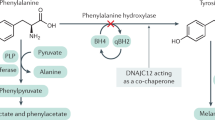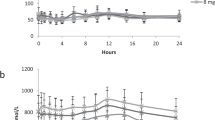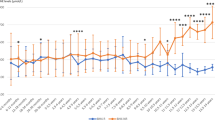Abstract
THE mechanism by which mental defect is produced in phenylketonuria is unknown. No correlation has been found in patients having this disorder between the degree of mental defect and blood-levels of phenylalanine or phenylpyruvate, or urinary excretion of phenylalanine, phenyllactate, phenylpyruvate or o-hydroxyphenylacetate1. The possible implication of biologically active amines has been examined in several papers. Mitoma et al. 2 administered o-tyrosine and m-tyrosine to experimental animals and observed conversion to the corresponding amines in brain, with attendant central nervous system stimulation and convulsions. Association of the mental defect in phenylketonuria with an excessive production of o-tyramine was suggested. It also seems possible that overproduction of phenylethylamine may be responsible for the disturbance in cerebral metabolism. Jepson et al. 3 have recently shown that administration of a monoamine oxidase inhibitor to phenylketonuric individuals results in an increase much greater than normal in the urinary excretion of phenylethylamine, but not of o-tyramine. The mental defect in phenylketonuria may also be due to an underproduction of amines vital to normal brain function. Pare et al. 4 have reported low serum serotonin-levels and decreased urinary excretion of 5-hydroxyindoleacetic acid in phenylketonuria. They suggest that one or more aromatic acid metabolites of phenylalanine inhibit 5-hydroxytryptophan de-carboxylase, the enzyme responsible for the production of serotonin.
This is a preview of subscription content, access via your institution
Access options
Subscribe to this journal
Receive 51 print issues and online access
$199.00 per year
only $3.90 per issue
Buy this article
- Purchase on Springer Link
- Instant access to full article PDF
Prices may be subject to local taxes which are calculated during checkout
Similar content being viewed by others
References
Knox, W. E., and Hsia, D. Y.-Y., Amer. J. Med., 22, 687 (1957).
Mitoma, C., Posner, H. S., Bogdanski, D. F., and Udenfriend, S., J. Pharm. and Exper. Therap., 120, 188 (1957).
Jepson, J. B., Lovenberg, W., Zaltzman, P., Oates, J. A., Sjoerdsma, A., and Udenfriend, S., Biochem. J., 74, 5, P (1960).
Pare, C. M. B., Sandler, M., and Stacey, R. S., Arch. Dis. Childhood, 34, 422 (1959).
Allan, J. D., Cusworth, D. C., Dent, C. E., and Wilson, V. K., Lancet, i, 182 (1958).
Awapara, J., Davis, V. E., and Graham, O., J. Chromat., 3, 11 (1960).
Rodnight, R., Biochem. J., 64, 621 (1956).
Sachs, jun., E., J. Neurosurg., 14, 22 (1957).
Weil-Malherbe, H., and Liddell, D. W., J. Neural. Neurosurg. and Psychiat., 17, 247 (1954).
Author information
Authors and Affiliations
Rights and permissions
About this article
Cite this article
PERRY, T., SHAW, K. & WALKER, D. Apparent Absence of Amines in Cerebrospinal Fluid of Phenylketonurics. Nature 189, 926–927 (1961). https://doi.org/10.1038/189926a0
Issue Date:
DOI: https://doi.org/10.1038/189926a0
Comments
By submitting a comment you agree to abide by our Terms and Community Guidelines. If you find something abusive or that does not comply with our terms or guidelines please flag it as inappropriate.



